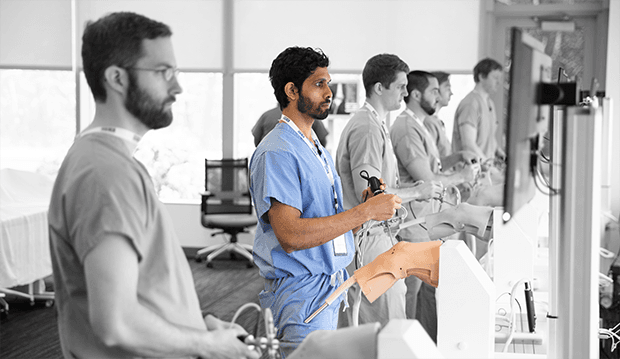
Training in a Time of Social Distancing
COVID-19 has accelerated the move to online and virtual medical education, and these new learning opportunities have many benefits that are here to stay.
COVID-19 has highlighted both the strengths and weaknesses of traditional medical training. Out of necessity, elective surgeries have been put on hold, scientific conferences and travel have been cancelled, and medical post-graduates have been co-opted into more pressing roles. Hospitals have started to limit the number of physicians per unit and some have been forced to eliminate clinical placements altogether. Some physicians have been furloughed, and other are unable to progress in their residency programs as part of their ongoing specialization. These new limitations have left many educators struggling to find alternative training opportunities for their students.
The Accreditation Council for Graduate Medical Education (ACGME) has issued statements acknowledging the pandemic’s impact on training, but emphasized that “Under all circumstances, Sponsoring Institutions, in partnership with their programs and participating sites, must ensure educational continuity and the fulfillment of their obligations to residents, fellows, and others in the clinical learning environment.” The American Board of Medical Specialties (ABMS), which certifies physicians in the United States, has adopted a stance of flexibility concerning disruptions in training during COVID-19, for example “deferment of activities or requirements and/or the extension of cycle deadlines,” however these are only short-term solutions to what could be a long-term and recurring problem.
Cognizant of institutions’ difficulties the ACGME has encouraged programs to utilize “remote conferencing technology, web-based resources, and other innovative tools.” This stance has been echoed by other organizations, and a joint statement by the respective presidents of the International Nursing Association of Clinical Simulation and Learning (INACSL) and the Society for Simulation in Healthcare (SSH) encouraged that “regulatory bodies and policymakers demonstrate flexibility by allowing the replacement of clinical hours usually completed in a healthcare setting with that of virtually simulated experiences.” Almost all states in the United States permit up to 25% of clinical hours to be simulation-based, while some states allow upwards of 50%.
Many organizations have already turned to online education for training focusing on COVID-19, and some are now transitioning online platforms to other training needs. For example, Swiss simulation company VirtaMed, recently partnered with ISUOG – the leading international society of professionals in ultrasound for obstetrics and gynecology - to deliver a joint seminar with ISUOG seminar on ultrasound basic training. Working with Dr. Gihad Chalouhi and using VirtaMed’s obstetric ultrasound simulator, GynoS™, attendees took part in two hours of lectures, discussions, and practice on the ultrasound simulator. Trainees have also individually turned to simulators where they have access:
The American College of Obstetricians and Gynecologists (ACOG) already offers online educational and professional development opportunities, and the American Orthopaedic Society for Sports Medicine (AOSSM) just started a Sports Medicine Fellows Webinar Series. Many other organizations and associations have followed suit, yet they are still faced with the challenge of how trainees can acquire operative skills beyond the knowledge shared in webinar format.
As a compliment to webinars, there is an acceleration towards incorporating simulation into medical training. Many well-regarded medical schools have established simulation centers where competency-based simulation programs give trainees the opportunity to learn independently, respecting both social distancing and the need to reduce team sizes in the OR. This demonstrates a streamlining of the educational pipeline where trainees can learn the basics and theory online, then gain hands-on skills with simulators before progressing to more complex skills in cadaver labs and then the OR. This streamlining reduces training cost, time, and the risk to both patients and trainees.
VirtaMed’s new education program, VirtaMedEd, offers a variety of webinars and additional content to help medical professionals meet their training needs.

VirtaMed is a medical education company that believes competency-based medical education is best delivered using high-fidelity mixed reality simulators. The Swiss-based company has teams in the USA and China, supported by a global network of experts in simulation training for orthopedics, general surgery, urology, obstetrics and gynecology.
References
ABMS News. (2020, March 26). ABMS Statement Regarding Continuing Certification During Covid-19. Retrieved from https://www.abms.org/news-events/abms-statement-regarding-continuing-certification-during-covid-19/
Accreditation Council for Graduate Medical Education. (2020, n.d.). Frequently Asked Questions. Retrieved from https://www.acgme.org/COVID-19/Frequently-Asked-Questions
ACGME News. (2020, April 9). ACGME Statement on Furloughs Resulting from the COVID-19 Pandemic Emergency. Retrieved from https://www.acgme.org/Newsroom/Newsroom-Details/ArticleID/10194/ACGME-Statement-on-Furloughs-Resulting-from-the-COVID-19-Pandemic-Emergency
American College of Obstetricians and Gynaecologists. (2020). Continuing Medical Education. Retrieved from https://www.acog.org/education-and-events/cme-program
AOSSM. (2020). Sports Medicine Fellows Webinar Series. Retrieved from https://www.sportsmed.org/aossmimis/Members/Education/Sports_Medicine_Fellows_Webinar_Series.aspx
Goldberg, E. (2020, March 20). Coronavirus may keep California’s nursing students from graduating. Retrieved from https://www.nytimes.com/2020/03/20/health/coronavirus-nurses-healthcare.html?smid=em-share
Waxman, KT. And C. Durham. (2020, 30 March). Use Simulation to Replace Much Needed, Lost Clinical Experiences due to COVID19: Strategies and Recommendations. SSH SimSeries Webinar. Retrieved from https://www.ssih.org/Portals/48/SSH%20Sim%20Series%20_COVID19_Contingencies_Final_1.pdf
Office of the Texas Governor. Governor Abbott takes action to expand the nursing workforce. Press Release. Retrieved from https://gov.texas.gov/news/post/governor-abbott-takes-action-to-expand-nursing-workforce
Rupp, C. (2020, March 31). Covid-19:SSH/INACSL Position Statement on Use of Virtual Simulation during the Pandemic. Retrieved from https://www.ssih.org/COVID-19-Updates/ID/2237/COVID-19-SSHINACSL-Position-Statement-on-Use-of-Virtual-Simulation-during-the-Pandemic